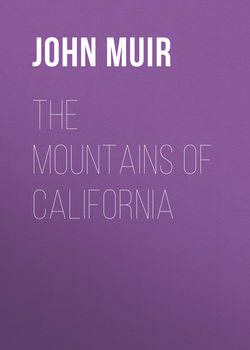The Mountains of California

Реклама. ООО «ЛитРес», ИНН: 7719571260.
Оглавление
John Muir. The Mountains of California
CHAPTER I. THE SIERRA NEVADA
CHAPTER II. THE GLACIERS
CHAPTER III. THE SNOW
CHAPTER IV. A NEAR VIEW OF THE HIGH SIERRA
CHAPTER V. THE PASSES
CHAPTER VI. THE GLACIER LAKES
CHAPTER VII. THE GLACIER MEADOWS
CHAPTER VIII. THE FORESTS
CHAPTER IX. THE DOUGLAS SQUIRREL (Sciurus Douglasii)
CHAPTER X. A WIND-STORM IN THE FORESTS
CHAPTER XI. THE RIVER FLOODS
CHAPTER XII. SIERRA THUNDER-STORMS
CHAPTER XIII. THE WATER-OUZEL
CHAPTER XIV. THE WILD SHEEP (Ovis montana)
CHAPTER XV. IN THE SIERRA FOOT-HILLS
CHAPTER XVI. THE BEE-PASTURES
Отрывок из книги
Of the small residual glaciers mentioned in the preceding chapter, I have found sixty-five in that portion of the range lying between latitude 36° 30' and 39°. They occur singly or in small groups on the north sides of the peaks of the High Sierra, sheltered beneath broad frosty shadows, in amphitheaters of their own making, where the snow, shooting down from the surrounding heights in avalanches, is most abundant. Over two thirds of the entire number lie between latitude 37° and 38°, and form the highest fountains of the San Joaquin, Merced, Tuolumne, and Owen's rivers.
The glaciers of Switzerland, like those of the Sierra, are mere wasting remnants of mighty ice-floods that once filled the great valleys and poured into the sea. So, also, are those of Norway, Asia, and South America. Even the grand continuous mantles of ice that still cover Greenland, Spitsbergen, Nova Zembla, Franz-Joseph-Land, parts of Alaska, and the south polar region are shallowing and shrinking. Every glacier in the world is smaller than it once was. All the world is growing warmer, or the crop of snow-flowers is diminishing. But in contemplating the condition of the glaciers of the world, we must bear in mind while trying to account for the changes going on that the same sunshine that wastes them builds them. Every glacier records the expenditure of an enormous amount of sun-heat in lifting the vapor for the snow of which it is made from the ocean to the mountains, as Tyndall strikingly shows.
.....
On the southern shore of a frozen lake, I encountered an extensive field of hard, granular snow, up which I scampered in fine tone, intending to follow it to its head, and cross the rocky spur against which it leans, hoping thus to come direct upon the base of the main Ritter peak. The surface was pitted with oval hollows, made by stones and drifted pine-needles that had melted themselves into the mass by the radiation of absorbed sun-heat. These afforded good footholds, but the surface curved more and more steeply at the head, and the pits became shallower and less abundant, until I found myself in danger of being shed off like avalanching snow. I persisted, however, creeping on all fours, and shuffling up the smoothest places on my back, as I had often done on burnished granite, until, after slipping several times, I was compelled to retrace my course to the bottom, and make my way around the west end of the lake, and thence up to the summit of the divide between the head waters of Rush Creek and the northernmost tributaries of the San Joaquin.
Arriving on the summit of this dividing crest, one of the most exciting pieces of pure wilderness was disclosed that I ever discovered in all my mountaineering. There, immediately in front, loomed the majestic mass of Mount Ritter, with a glacier swooping down its face nearly to my feet, then curving westward and pouring its frozen flood into a dark blue lake, whose shores were bound with precipices of crystalline snow; while a deep chasm drawn between the divide and the glacier separated the massive picture from everything else. I could see only the one sublime mountain, the one glacier, the one lake; the whole veiled with one blue shadow—rock, ice, and water close together without a single leaf or sign of life. After gazing spellbound, I began instinctively to scrutinize every notch and gorge and weathered buttress of the mountain, with reference to making the ascent. The entire front above the glacier appeared as one tremendous precipice, slightly receding at the top, and bristling with spires and pinnacles set above one another in formidable array. Massive lichen-stained battlements stood forward here and there, hacked at the top with angular notches, and separated by frosty gullies and recesses that have been veiled in shadow ever since their creation; while to right and left, as far as I could see, were huge, crumbling buttresses, offering no hope to the climber. The head of the glacier sends up a few finger-like branches through narrow couloirs; but these seemed too steep and short to be available, especially as I had no ax with which to cut steps, and the numerous narrow-throated gullies down which stones and snow are avalanched seemed hopelessly steep, besides being interrupted by vertical cliffs; while the whole front was rendered still more terribly forbidding by the chill shadow and the gloomy blackness of the rocks.
.....